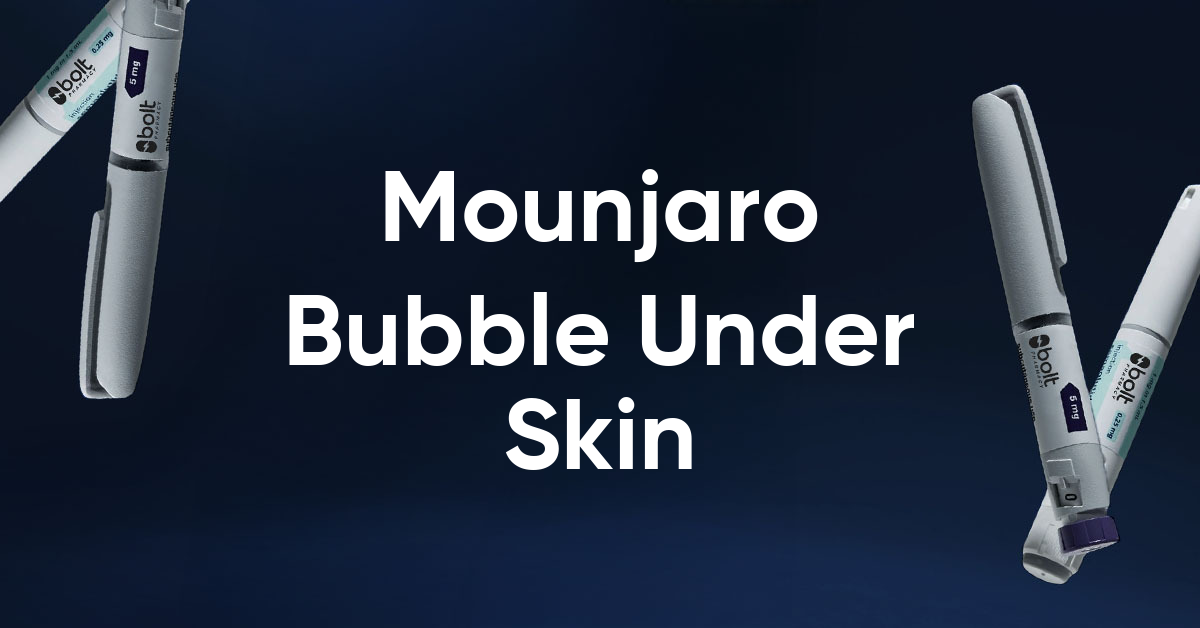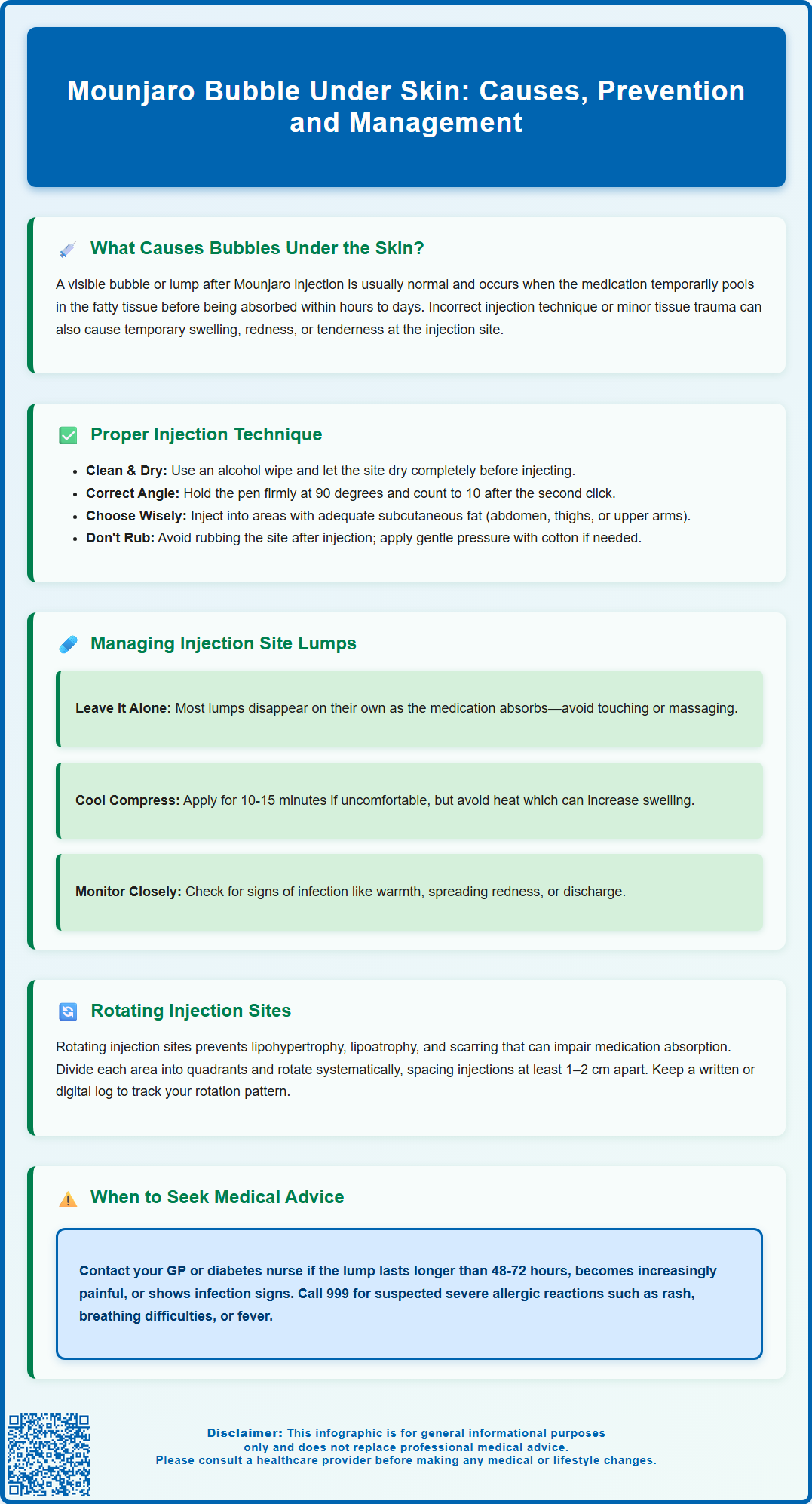Wegovy®
A weekly GLP-1 treatment proven to reduce hunger and support meaningful, long-term fat loss.
- ~16.9% average body weight loss
- Boosts metabolic & cardiovascular health
- Proven, long-established safety profile
- Weekly injection, easy to use

Mounjaro (tirzepatide) is a once-weekly subcutaneous injection prescribed for type 2 diabetes mellitus management in the UK. Some patients notice a visible bubble or lump under the skin after injecting Mounjaro, which can cause understandable concern. These injection site reactions are typically harmless and result from the medication pooling temporarily in the subcutaneous tissue before absorption. Understanding why bubbles form, how to inject correctly, and when to seek medical advice can help patients use Mounjaro safely and effectively whilst minimising injection site complications.
Summary: Bubbles under the skin after Mounjaro injections are usually harmless and occur when the medication temporarily pools in subcutaneous tissue before being absorbed into the bloodstream.
Mounjaro (tirzepatide) is a once-weekly subcutaneous injection used for the management of type 2 diabetes mellitus in the UK. When administered correctly, the medication is delivered into the subcutaneous tissue—the layer of fat beneath the skin. Some patients notice a visible bubble, lump, or swelling at the injection site shortly after administration. Understanding the underlying causes can help alleviate concern and improve injection technique.
Common causes of bubbles under the skin include:
Subcutaneous depot formation: When Mounjaro is injected into the fatty tissue, the liquid medication temporarily pools in a small pocket before being absorbed into the bloodstream. This is a normal physiological response and typically resolves within hours to days as the body absorbs the medication.
Injection technique issues: Using incorrect technique with the Mounjaro autoinjector, such as not holding it firmly against the skin at a 90-degree angle or removing it too quickly after injection, may affect how the medication is deposited in the tissue.
Localised inflammation: The injection process itself causes minor tissue trauma, and the body's inflammatory response can lead to temporary swelling, redness, or tenderness at the site.
Injection site reactions are recognised in the Mounjaro Summary of Product Characteristics (SmPC) and are usually mild and self-limiting. Most do not affect the medication's efficacy. However, if the lump persists beyond 48–72 hours, becomes increasingly painful, or shows signs of infection (warmth, spreading redness, discharge), patients should contact their GP or diabetes specialist nurse for assessment.

Correct injection technique is fundamental to minimising injection site reactions, including bubbles and lumps. In the UK, Mounjaro is supplied as a single-use pre-filled autoinjector, which simplifies administration but still requires careful attention to technique. Following the manufacturer's instructions is essential for proper administration.
Step-by-step injection technique:
1. Prepare the injection site: Choose an appropriate area with adequate subcutaneous fat—typically the abdomen (avoiding a 5 cm radius around the navel), front or outer thighs, or the back of the upper arms. Clean the site with an alcohol wipe and allow it to dry completely to prevent stinging and ensure effective antisepsis.
2. Check the pen: Inspect the Mounjaro pen for any visible particles or discolouration. The solution should be clear and colourless to slightly yellow. Do not use if the medication appears cloudy or contains particles.
3. Remove the cap: Pull the grey base cap straight off the pen. You should hear a 'click' sound.
4. Position the pen: Place the clear base flat and firmly against your skin at a 90-degree angle. Pinching the skin is not routinely required with the autoinjector unless specifically advised by your healthcare professional for very lean individuals.
5. Unlock and inject: Unlock the pen by turning the lock ring. Press and hold the green injection button. You will hear a click. Continue holding the pen firmly against your skin and count slowly to 10 after the second click to ensure the full dose is delivered.
6. Confirm and dispose: After removing the pen, check that the grey plunger is visible in the window, confirming the dose was delivered. Do not rub the injection site afterwards. Apply gentle pressure with a clean cotton ball if needed. Dispose of the used pen in a sharps container according to local guidelines.
By following these steps consistently and according to the manufacturer's instructions, patients can optimise medication delivery and reduce the formation of visible lumps or bubbles under the skin.
Most injection site lumps following Mounjaro administration are benign and resolve spontaneously without intervention. However, understanding appropriate management strategies can provide reassurance and help identify situations requiring medical attention. The majority of subcutaneous bubbles represent normal medication absorption and do not compromise treatment efficacy.
Self-care measures for managing injection site lumps:
Avoid manipulation: Resist the urge to massage, squeeze, or repeatedly touch the lump. Excessive manipulation can increase inflammation, delay absorption, and potentially introduce bacteria, raising the risk of infection.
Monitor the site: Observe the lump over 24–48 hours. Most bubbles will gradually diminish as the medication is absorbed into the systemic circulation. Take note of any changes in size, colour, or associated symptoms.
Apply a cool compress: If the site is uncomfortable or slightly swollen, a clean, cool (not ice-cold) compress applied for 10–15 minutes can help reduce inflammation and provide symptomatic relief. Avoid applying heat, as this may increase swelling.
Maintain hygiene: Keep the injection site clean and dry. Avoid tight clothing that may irritate the area. Normal bathing and showering are fine, but avoid hot tubs or swimming pools if the site is inflamed.
When to seek medical advice:
Whilst most injection site reactions are harmless, certain signs warrant prompt medical assessment:
Persistent lumps: A lump that remains unchanged or increases in size after 72 hours may indicate lipohypertrophy (fatty tissue buildup from repeated injections in the same area) or, rarely, an abscess.
Signs of infection: Increasing pain, warmth, spreading redness, purulent discharge, or fever suggest possible infection requiring antibiotic therapy.
Allergic reactions: Widespread rash, itching, difficulty breathing, or facial swelling may indicate a hypersensitivity reaction to tirzepatide or excipients. This requires urgent medical attention.
Unusual bruising or bleeding: Extensive bruising or prolonged bleeding from the injection site, particularly in patients taking anticoagulants, should be evaluated.
Patients should contact their GP, diabetes specialist nurse, or NHS 111 for guidance if any concerning symptoms develop. In cases of suspected severe allergic reaction, dial 999 immediately.
If you experience any side effects, talk to your healthcare professional. You can also report side effects directly via the Yellow Card Scheme at yellowcard.mhra.gov.uk or search for MHRA Yellow Card in the Google Play or Apple App Store.
Systematic rotation of injection sites is a cornerstone of safe subcutaneous medication administration and is recommended by Forum for Injection Technique (FIT UK) guidelines for all injectable diabetes therapies, including Mounjaro. Repeatedly injecting into the same area can lead to lipohypertrophy (abnormal fatty tissue accumulation), lipoatrophy (loss of fatty tissue), scarring, and increased injection site reactions, including persistent lumps and bubbles.
Why site rotation matters:
When the same injection site is used too frequently, the subcutaneous tissue does not have adequate time to recover between injections. This can result in:
Lipohypertrophy: Firm, rubbery lumps of fatty tissue that develop from repeated trauma and inflammation. These areas have reduced blood flow, which impairs medication absorption and can lead to unpredictable glucose control.
Reduced medication efficacy: Injecting into damaged or scarred tissue may result in erratic absorption of tirzepatide, potentially compromising glycaemic control.
Increased discomfort: Scar tissue and lipohypertrophy can make injections more painful and increase the likelihood of visible bubbles or prolonged lumps.
Implementing an effective rotation strategy:
1. Divide injection areas into zones: Mentally divide each approved injection area (abdomen, thighs, upper arms) into quadrants or sections. For example, the abdomen can be divided into four quadrants, avoiding the area immediately around the navel.
2. Use a systematic pattern: Rotate through different zones in a consistent pattern. For instance, if injecting weekly, use the right abdomen one week, left abdomen the next, then right thigh, left thigh, and so forth. Keep a written or digital log if helpful.
3. Space injections appropriately: Ensure each injection is at least 1–2 cm away from the previous injection site. Avoid injecting into the same spot with consecutive doses.
4. Inspect sites regularly: Before each injection, visually inspect and gently palpate potential injection sites. Avoid areas with lumps, bruising, scarring, redness, or tenderness. If lipohypertrophy is detected, avoid that area entirely until it resolves (which may take several months).
5. Seek professional guidance: Diabetes specialist nurses can provide personalised injection site rotation plans and assess your technique during routine appointments. They can also identify early signs of lipohypertrophy and recommend appropriate management.
By adhering to a structured rotation schedule, patients can minimise injection site complications, optimise Mounjaro absorption, and maintain better long-term glycaemic control whilst reducing the occurrence of bubbles and lumps under the skin.
No, bubbles under the skin after Mounjaro injection are usually harmless and represent normal medication pooling in subcutaneous tissue. Most resolve within 24–72 hours as the medication is absorbed, though you should contact your GP if the lump persists, becomes increasingly painful, or shows signs of infection.
To prevent lumps, hold the Mounjaro autoinjector firmly at a 90-degree angle against clean, dry skin, count slowly to 10 after the second click, and systematically rotate injection sites between the abdomen, thighs, and upper arms, spacing each injection at least 1–2 cm from the previous site.
Contact your GP or diabetes specialist nurse if the lump persists beyond 72 hours, increases in size, or shows signs of infection such as increasing pain, warmth, spreading redness, discharge, or fever. Dial 999 if you experience symptoms of severe allergic reaction including difficulty breathing or facial swelling.
The health-related content published on this site is based on credible scientific sources and is periodically reviewed to ensure accuracy and relevance. Although we aim to reflect the most current medical knowledge, the material is meant for general education and awareness only.
The information on this site is not a substitute for professional medical advice. For any health concerns, please speak with a qualified medical professional. By using this information, you acknowledge responsibility for any decisions made and understand we are not liable for any consequences that may result.
Lorem ipsum dolor sit amet, consectetur adipiscing elit, sed do eiusmod tempor incididunt ut labore et dolore magna aliqua. Ut enim ad minim veniam, quis nostrud exercitation ullamco laboris nisi ut aliquip ex ea commodo consequat. Duis aute irure dolor in reprehenderit in voluptate velit esse cillum dolore eu fugiat nulla pariatur.
Block quote
Ordered list
Unordered list
Bold text
Emphasis
Superscript
Subscript